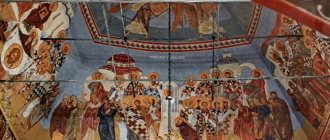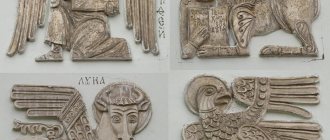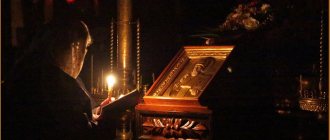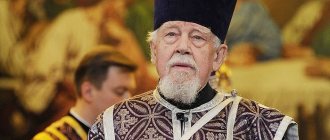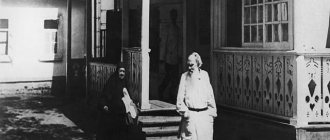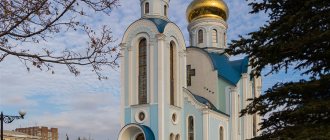Definitions
Definition of the Holy Council of the Orthodox Russian Church on unity of faith. February 22 (March 7), 1918
- Fellow believers are the children of the One Holy Catholic and Apostolic Church, who, with the blessing of the Local Church, with the unity of faith and government, perform church rites according to the liturgical books published under the first five Russian Patriarchs, while strictly maintaining the ancient Russian way of life.
- Edinoverie parishes are part of Orthodox dioceses and are governed, by definition of the Council or on behalf of the ruling Bishop, by special Edinoverie Bishops, dependent on the diocesan Bishop.
- Diocesan Bishops have the same archpastoral care for the religious life of Edinoverie parishes as for Orthodox parishes; when reviewing the diocese, they visit Edinoverie parishes and serve in them according to the charter adopted in Edinoverie churches; Also, the Bishops of the same faith, who are in charge of the parishes of the same faith on behalf of the diocesan Bishop, with his blessing visit the Edinoverie and Orthodox parishes and serve in the latter according to the rite accepted in the Orthodox Church, giving the ruling Bishop a report on his entire trip.
- Bishops of the same faith receive a name from the city or other populated place with a parish of the same faith, but not from those included in the title of the ruling Bishop.
- Bishops of the same faith participate in Local Councils of the Orthodox Russian Church in the number determined by the Charter of the Council.
- Candidates for Edinoverie Bishops are elected at a meeting of representatives of Edinoverie clergy and laity under the chairmanship of the local ruling Bishop, who submits the act of election, with his review, for approval by the highest church authorities. Elected Edinoverie Bishops are appointed by Orthodox and Edinoverie Bishops.
- Under bishops of the same faith, deaneries with deanery councils under them exist on a common basis.
- In parishes there are Parish Assemblies and Councils on a general basis.
- All clergy and ecclesiastical positions in parishes of the same faith are filled in the generally established church order at the choice of parish communities with the approval of the Bishop of the same faith.
- In order to improve and strengthen unity of faith, co-religionists are given the right to gather at diocesan, district and All-Russian congresses to discuss issues about the needs of unity of faith. District and All-Russian congresses are presided over by the Bishop indicated by the Holy Patriarch and the Holy Synod, and at diocesan congresses of the same faith, either the local Edinoverie Bishop, on behalf of the ruling Bishop, or the diocesan Bishop himself presides.
- All relations with the highest church authorities regarding the affairs of fellow believers of the diocese are conducted through the diocesan Bishop. Petitions for the establishment of a single-faith bishopric in one or another diocese, indicating the funds for its maintenance, are also submitted through the local diocesan Bishop.
- In churches and monasteries of the same faith, ancient singing and the ancient order of service must be strictly preserved; the leaders of the monasteries and clergy of churches should not allow changes to the ancient order.
- At general solemn services, arranged by mutual agreement of Orthodox and Edinoverie parishes, chants are sung according to the rite of both parishes alternately.
- The transfer of co-religionists to Orthodox parishes, as well as Orthodox Christians to co-religionist parishes, is carried out without hindrance, since the books and rituals used by co-religionists during worship are also Orthodox. Persons moving from Edinoverie parishes to Orthodox and from Orthodox to Edinoverie parishes should not be subject to restrictions. Note. If at least four-fifths of the full-fledged parishioners request, Edinoverie parishes with churches are listed as Orthodox and Divine services are established in them according to the order blessed by the Council of 1667, and vice versa - Orthodox churches and parishes are transferred to the jurisdiction of the Edinoverie Bishop and services are performed in them according to the old printed books.
- In marriages where one of the spouses is a co-religionist and the other is Orthodox, the wedding takes place in a co-religionist or Orthodox church, by mutual agreement.
- Children of co-religionists, when entering Orthodox schools and colleges, and children of Orthodox Christians, studying in co-religionist schools, freely observe the charters and customs of their parishes.
- At Edinoverie churches and monasteries, where it turns out to be possible, special elementary and higher ranks, as well as pastoral schools are opened to instill in students love and affection for the ancient way of life, without blaspheming the general church rite, for the preparation of students for Edinoverie schools and candidates for the degree of clergy and to get acquainted with how to fight the split.
- Edinoverie clergy are not exempt from collecting for the general needs of the entire Orthodox Russian Church and diocese, but edinoverie clergy for local religious educational institutions and diocesan charitable institutions.
- For parishes of the same faith who have declared a desire to have bishops of the same faith and have indicated sufficient funds for the maintenance of them and their Offices, with the consent of the diocesan Bishops, chairs of the same faith Bishops are established in the dioceses of: Petrograd - Okhtenskaya with residence for the Bishop in Petrograd, in the Nizhny Novgorod diocese - Pavlovsk with residence for the Bishop in the village. Pavlov, in the Ufa diocese - Satkinskaya with residence for the Bishop in the Chrysostom Resurrection Monastery of Edinoverie and in the Tobolsk diocese - Tyumen with residence for the Bishop in Tyumen.
Holy Council of the Orthodox Russian Church. Collection of definitions and regulations. Second issue. Second appendix to the Acts. Moscow - 1918. Publication of the Cathedral Council. Definition I. pp. 3-5.
Definition of the Holy Council of the Russian Orthodox Church On the order of glorifying saints for local veneration on August 21 (September 3), 1918.
- The glorification of the saint of God to local veneration in the Russian Orthodox Church is carried out by the Council of the Metropolitan District with the blessing of the Holy Patriarch and the Holy Synod taught through a special charter. Note. Pending the proper organization of metropolitan districts and district councils, glorification is performed by His Holiness the Patriarch with the Holy Synod.
- The petition for the glorification of the saint of God to local veneration comes from the local Orthodox population, with the blessing of the diocesan Bishop.
- In order for a saint of God to be considered a local saint, it is necessary that the godly life of a righteous person be evidenced by the gift of miracles after his death and by popular veneration of him.
- Before the glorification of the saint, his miracles, recorded by those who honor his memory and the clergy, are verified by a special commission appointed by the diocesan Bishop, with the blessing of the Metropolitan or the Supreme Church Authority.
- When verifying miracles, claimants and witnesses give testimony under oath about the validity of the recorded miraculous signs.
- Witnessing and opening relics is not necessary for the saint of God to be considered a local saint. If the witnessing of the relics of a saint of God is carried out, then it is performed with the blessing of His Holiness the Patriarch and in the presence of his representative.
- With the blessing of the diocesan Bishop, a previously compiled life of the saint is compiled or reviewed and the correspondence of the life with the testimonies and records of the saint’s contemporaries and chronicle records and tales is determined. From the life of the saint, a prologue or synaxarion is compiled for liturgical use.
- With the blessing of the diocesan Bishop, the church service for the saint (troparion, kontakion, stichera and canon) is compiled, and before this is compiled, the service is conducted according to the general Menaion. Newly composed liturgical hymns and prayers are allowed for liturgical use with the blessing of His Holiness the Patriarch and the Holy Synod.
- The day of celebration of the saint is established with the blessing of the district Council or the Supreme Church Authority.
- The name of the saint is included in the general church monthly with an indication of the local celebration of the saint.
- Upon receiving the blessing for the glorification of the saint of God, the upcoming celebration is announced to everyone through the publication in the “Church Gazette” of the patriarchal charter, a short life of the glorified saint, a troparion and a kontakion for him, which by this time should be compiled.
- The rite of glorification of the saint is compiled by the local diocesan authorities and approved by His Holiness the Patriarch and the Holy Synod.
- The recognition of a locally revered saint among the general church saints belongs to the Priestly Council of the Russian Church. But even before such glorification, service to him as a saint can be performed, at the request of those who honor him, everywhere.
- The name of the saint, glorified for the general church celebration, is printed in the general church Russian monthly without indicating the local celebration of the saint.
- The Holy Patriarch, with a special message, brings to the attention of the Ecumenical Patriarch and the primates of other autocephalous Churches about the glorification of the saints for general church veneration.
Women received the right to vote in the Church
The definition adopted at the Council “On the involvement of women in active participation in various fields of church service” gave women the right to participate and vote in parish, dean and diocesan meetings - an unprecedented case in the history of the Russian Church. At the Council itself there were no female members, but abbesses of several monasteries were invited as experts to the meetings of the department on monasteries and monastics. It is curious that this happened against the backdrop of women being given voting rights in state elections after the revolution.
Subsequently, the trend toward increased participation of women in church ministry continued. For example, from the second half of the 20th century, elected abbess of monasteries became full members of Local Councils.
Collection of definitions and Acts of the Holy Council of the Orthodox Russian Church 1917-1918.
Collection of definitions and decrees Acts - volume 1 (part 1 part 2) Acts - volume 2 (part 1 part 2) Acts - volume 3 Acts - volume 4 Acts - volume 5 Acts - volume 6 Acts - volume 7 Acts - volume 8 Acts - volume 9 Acts - Volume 10 Acts - Volume 11
